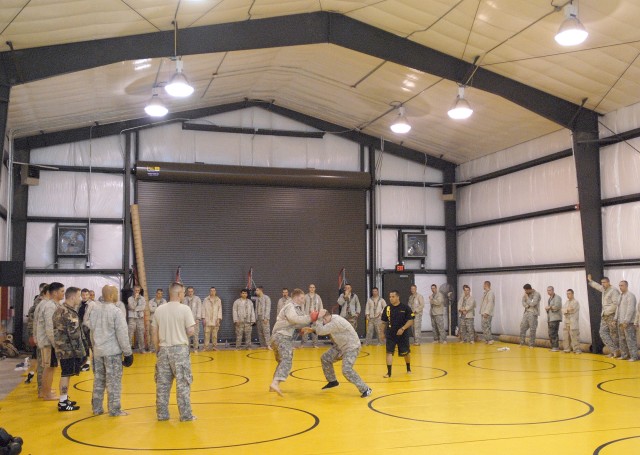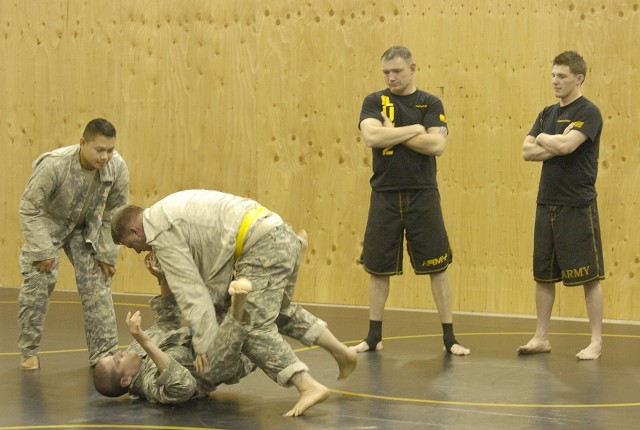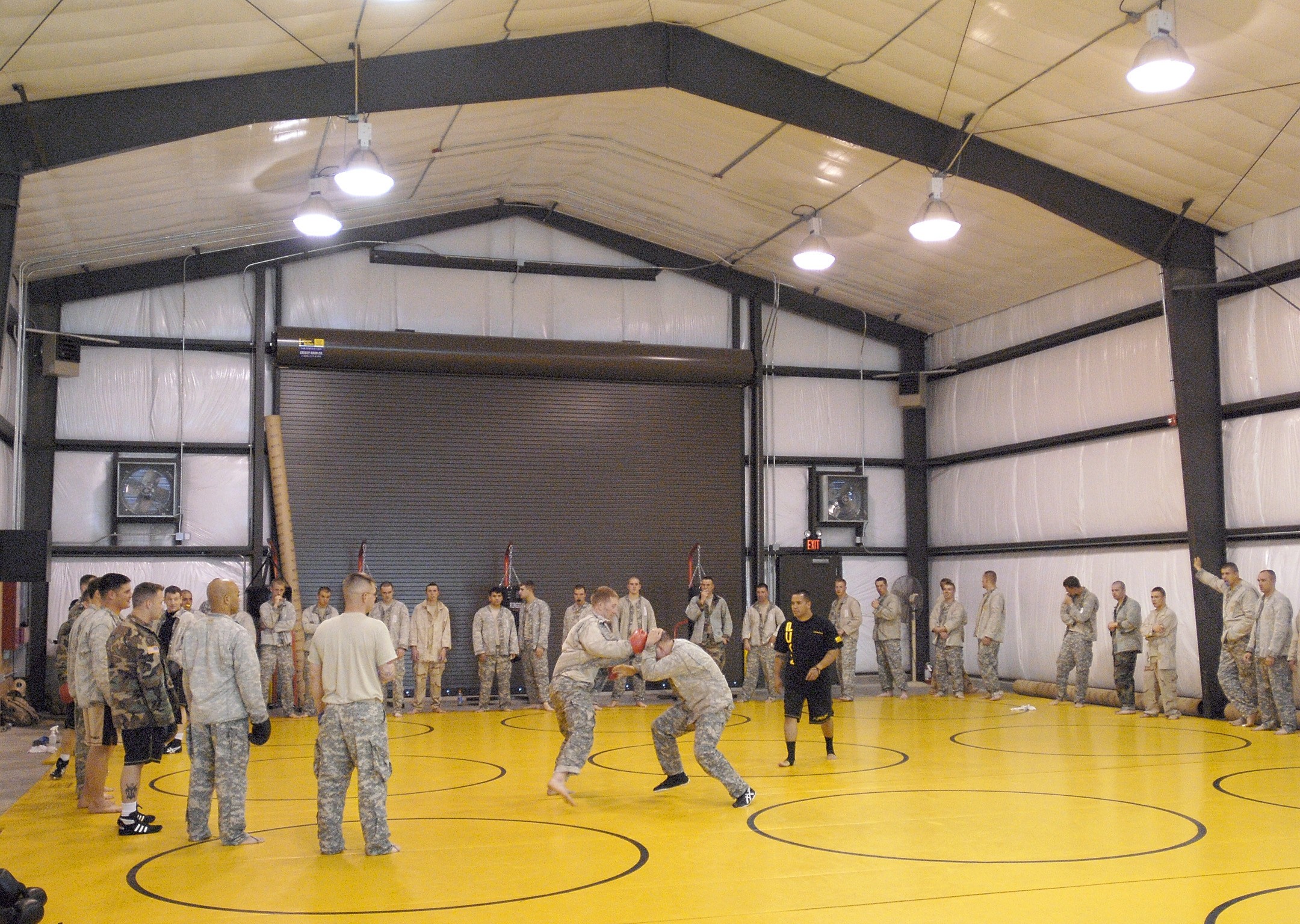FORT LEWIS, Wash. - Though people sometimes compare the war in Iraq, to the Vietnam conflict, the homes and buildings of Iraq and the deserts that blanket most of the Arabian Gulf region, stand in stark contrast to the jungles and rice paddies Americans faced in Southeast Asia.
Because the modern Soldier spends more time clearing rooms and engaging the enemy in hand-to-hand combat than those Soldiers before him, a renewed emphasis has been put on the importance of subduing an enemy without a weapon.
That isn't to say Soldiers of yesteryear never had to rely on a swift hand to best an enemy. It's just that America's desert Soldier of the 21st century finds himself coming into close contact with the enemy on a more frequent basis than before.
And thanks to a former Fort Lewis Army Ranger, today's Soldier is becoming better trained to effectively neutralize that close-quarters threat.
The early years
In 1995, Matt Larsen, then a squad leader in 2nd Battalion, 75th Ranger Regiment, was charged with bringing back to life a practical style of martial arts for the Army by then battalion commander, Lt. Col. Stanley McCrystal. Essentially, what he was tasked with was building what has become the Modern Army Combatives Program.
So Larsen brought together a group of Soldiers who studied various martial arts off post and began testing out the applicability of each style. Larsen and his group of trailblazers even trained by the handbook of the Marine Corps Martial Arts Program, but, as Sgt. 1st Class Michael Robinson, then a private, said, "It didn't really work when we went to live training. You put two dudes against each other with gloves on and they resorted back to other stuff every time."
After flirting with the idea of seeking council from Russian martial arts experts, Larsen, on the recommendation of Vietnam-era Ranger and University of Minnesota wrestling head coach J. Robinson, decided the Brazilian jiu-jitsu taught by the famous Gracie family was the way to go.
"I remember the Gracies came up and we had a class with them; Royce Gracie, he was the first guy," recalled Robinson, who serves as the Level IV Master Trainer for 3rd Brigade, 2nd Infantry Division. "He had 30 guys from the battalion and he went down the row and beat each dude individually in a row, no breaks, and he was barely breaking a sweat by the end. He was choking dudes out, arm bars, leg bars - you name it, he was throwing it on these guys. He was just destroying these guys. And then he was like, 'OK, now let me show you how I did it.' And that's what started the combatives program for the Ranger battalion."
The 2-75 Rangers' first chance to put its newly-learned skills on display came at a Joint Readiness Training Center during which an impromptu combatives pit formed between the 1-75 Rangers, the 2-75 Rangers and a company of 3-75 Rangers.
After what equated to a full day's work worth of competition, it became glaringly apparent the training Larsen had put his Rangers through had stuck.
"Everybody was talking smack back and forth so we made a pit and said 'bring it!' So we went at it," Robinson said. "And after about eight hours, in our battalion, we only lost three matches. You just walk out there and somebody from the other battalion would go out there and meet you, he'd be about of equal size, and you would fight in front of about 400 to 500 people and you just went until you tapped out, and we just dominated."
Grass roots growth
As is common with Ranger battalions, Soldiers eventually began transfering to new posts taking with them their newfound fighting skills. Many of them then taught their new brothers-in-arms. Larsen was no different and found himself in the Ranger Training Brigade at Fort Benning, Ga.
It was there that Larsen was charged with instituting his combatives program at an Armywide level. And after selling his idea to the right people, he opened the fight house, which now serves as home to the Modern Army Combatives Program, of which he was the NCO in charge. In 2002, Larsen rewrote the field manual on Army Combatives, officially named FM 3-25.150 (Combatives), his guidelines became official Army doctrine.
He was then reassigned to the 11th Infantry Regiment where he, in 2005, developed a four-level, train-the-trainer course, which became known as the United States Army Combatives School. Now retired, he is the civilian in charge of the combatives program. That training is now a requirement for passing initial entry training and is included in the Warrior Tasks List, which is required knowledge for every Soldier.
Though continuously being tweaked to meet the training needs of an Army at war, Larsen's combative school now has firm doctrine, breaking the school down into four levels, and a strong sense of practicality.
"The most important thing about the combatives program," said Sgt. 1st Class Carl Lawler, a Level III certified instructor, "is that it teaches Soldiers to have the willingness to close the distance with the enemy. We can shoot guys from three meters away, but once we get man-on-man contact some guys get lost as to what to do there."
In a close, one-on-one situation with the enemy the goal is not necessarily to kill the enemy, according to Robinson and Lawler, as much as it is to subdue him and hold him down until a fellow Soldier arrives to help.
"That's one of the mantras of the whole thing," Robinson said, "is Rule No. 1, who wins in a hand-to-hand combat' The guy whose friend shows up with a gun first."
Working through the levels:
Level I
Each Soldier going through the program begins as a Level I student, where basic jiu-jitsu moves are taught in the weeklong class. It is also here where many can be in for a rude awakening, especially when having to pass the "Achieve the Clinch" drill.
"Some people have never been hit in the face before," Lawler said. "Some may freak out and go the other way."
It is that instinct of turning away from an assailant once he lands a punch that the drill seeks to break Soldiers of. The drill is a four-round exercise in which the student must engage the instructor who, while wearing boxing gloves, punches the student in the face and body until the student achieves one of the four clinches: rear clinch, modified seatbelt position, double under-hooks with body-lock, and the wall, in which the Soldiers control their opponents up against a wall with one under-hook in.
The intensity of the punching increases each round, and as Spc. Allen Groth, a Soldier in Alpha Co., 5th Battalion, 20th Infantry Regiment, found out, it's not as easy as it looks.
"It's like being in combat," he said. "It's an adrenaline rush to get to your opponent and get the fight stopped as fast as possible. (I'm thinking) I just need to get inside and get the task done so he can't hit me anymore."
Though taking his fair share of shots during the drill, Groth not only has already signed up for Level II, he'll be making sure guys in his unit follow in his footsteps.
"Once I get back to my unit, I'm going to make all my Joes and all my guys under me take this too," he said, "because I think it helps you progress as a Soldier because it helps instill more discipline."
Level II
While Level I is a 40-hour introduction to the combatives program, Level II is a two-week course in which students learn about 50 different moves compared to the 20 at Level I.
"It's a lot more intense, there's a lot more rolling," said Sgt. Brian Stegemoller, a Level III certified instructor. "It's a lot better work out and better training. After Level II, they're a lot more efficient in combatives. Level II is more practical."
The idea behind Level II, according to Stegemoller, is to teach the students how to counter all the things they learned in Level I so they are able to teach Level I moves to their troops and yet still hold the upper hand.
The two big days for students during Level II are tournament day and the 2-on-1 drill.
On tournament day, the 18 students organize themselves into a bracket-style tourney where they not only compete against each other, they also learn to keep score, keep time and referee matches.
For the 2-on-1 drill, "we have one guy, who stands there, and he's like an Iraqi guy, then we have two guys. One guy simulates holding a weapon and the other guy tries to calm him down so he can search him," said Stegemoller. "The 'Iraqi' guy, who has boxing gloves on, gets crazy so the two guys have to work together to submit him or subdue him until he taps out. So we teach the guys how to work together and use this stuff (in theater)."
As is true for all instructors at Fort Lewis, Level II student Staff Sgt. Aldo Gonzalez not only trains in the Army Combatives Program, he also does so in the civilian world.
"I think the program is awesome," said Gonzalez who is in 1st Battalion, 38th Infantry Regiment.
"There's a lot of guys in here that don't have any experience at all," he said. "It's an opportunity for me to come in here and practice what I've learned and learn some new techniques, but not only that, to be able to teach some of the guys who don't know anything.
"I'm really excited about the program. I know a lot of people on Fort Lewis are excited about it, because, if you go and talk to the ATARS people, there's a waiting list," he said. "I'm really stoked that they finally implemented a program here."
On the final day of Level II, students get to wear high-impact Blauer suits and get a feel for Level III, where Kali sticks and other weapons are used.
Levels III & IV
Most Level III classes are held at the combatives program's home at Fort Benning, though there are three groups of mobile training teams that are constantly going from post to post training Soldiers.
The next Level III class to be held at Fort Lewis is scheduled for late August.
Level IV classes, as do Level III classes, last for a full month. Unlike Level III classes, though, Level IV classes are taught solely at Fort Benning.
The future
As was true for many Soldiers serving during our country's previous wars, it seems as though this generation's warriors will also become familiar with fighting on foreign soil.
And though the reasons for the wars and the terrain on which they are being fought on may differ, there are two truths that remain constant throughout. First, each Soldier is fighting for his or her fellow Joe. Second, each Soldier wants to eventually make it home alive.
The skills learned in the Modern Army Combatives Program can help accomplish both.
"Our end-stated goal is to change the culture of the Army to where a certain level of fighting is acceptable and is part of the culture," Robinson said. "Where it's OK to go out and just roll. It's the easiest thing because all you need is a person. Level I should be something you learn at Basic Training. There's more than enough time there broken down that you can learn it. I (also) think the 'Achieve the Clinch' drill should be mandatory in order to pass Basic Training."
Matt Smith is a reporter with Fort Lewis' "Northwest Guardian."






Social Sharing